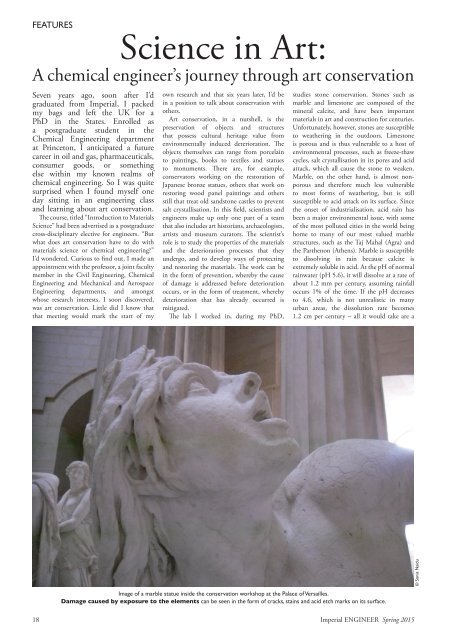I m p e r i a l ENGINEER
The house magazine of the City & Guilds College Association, CGCA, and Royal School of Mines Association, RSMA - now both parts of Imperial College, London
The house magazine of the City & Guilds College Association, CGCA, and Royal School of Mines Association, RSMA - now both parts of Imperial College, London
Create successful ePaper yourself
Turn your PDF publications into a flip-book with our unique Google optimized e-Paper software.
FEATURES<br />
Science in Art:<br />
A chemical engineer’s journey through art conservation<br />
Seven years ago, soon after I’d<br />
graduated from Imperial, I packed<br />
my bags and left the UK for a<br />
PhD in the States. Enrolled as<br />
a postgraduate student in the<br />
Chemical Engineering department<br />
at Princeton, I anticipated a future<br />
career in oil and gas, pharmaceuticals,<br />
consumer goods, or something<br />
else within my known realms of<br />
chemical engineering. So I was quite<br />
surprised when I found myself one<br />
day sitting in an engineering class<br />
and learning about art conservation.<br />
The course, titled “Introduction to Materials<br />
Science” had been advertised as a postgraduate<br />
cross-disciplinary elective for engineers. “But<br />
what does art conservation have to do with<br />
materials science or chemical engineering?”<br />
I’d wondered. Curious to find out, I made an<br />
appointment with the professor, a joint faculty<br />
member in the Civil Engineering, Chemical<br />
Engineering and Mechanical and Aerospace<br />
Engineering departments, and amongst<br />
whose research interests, I soon discovered,<br />
was art conservation. Little did I know that<br />
that meeting would mark the start of my<br />
own research and that six years later, I’d be<br />
in a position to talk about conservation with<br />
others.<br />
Art conservation, in a nutshell, is the<br />
preservation of objects and structures<br />
that possess cultural heritage value from<br />
environmentally induced deterioration. The<br />
objects themselves can range from porcelain<br />
to paintings, books to textiles and statues<br />
to monuments. There are, for example,<br />
conservators working on the restoration of<br />
Japanese bronze statues, others that work on<br />
restoring wood panel paintings and others<br />
still that treat old sandstone castles to prevent<br />
salt crystallisation. In this field, scientists and<br />
engineers make up only one part of a team<br />
that also includes art historians, archaeologists,<br />
artists and museum curators. The scientist’s<br />
role is to study the properties of the materials<br />
and the deterioration processes that they<br />
undergo, and to develop ways of protecting<br />
and restoring the materials. The work can be<br />
in the form of prevention, whereby the cause<br />
of damage is addressed before deterioration<br />
occurs, or in the form of treatment, whereby<br />
deterioration that has already occurred is<br />
mitigated.<br />
The lab I worked in, during my PhD,<br />
studies stone conservation. Stones such as<br />
marble and limestone are composed of the<br />
mineral calcite, and have been important<br />
materials in art and construction for centuries.<br />
Unfortunately, however, stones are susceptible<br />
to weathering in the outdoors. Limestone<br />
is porous and is thus vulnerable to a host of<br />
environmental processes, such as freeze-thaw<br />
cycles, salt crystallisation in its pores and acid<br />
attack, which all cause the stone to weaken.<br />
Marble, on the other hand, is almost nonporous<br />
and therefore much less vulnerable<br />
to most forms of weathering, but is still<br />
susceptible to acid attack on its surface. Since<br />
the onset of industrialisation, acid rain has<br />
been a major environmental issue, with some<br />
of the most polluted cities in the world being<br />
home to many of our most valued marble<br />
structures, such as the Taj Mahal (Agra) and<br />
the Parthenon (Athens). Marble is susceptible<br />
to dissolving in rain because calcite is<br />
extremely soluble in acid. At the pH of normal<br />
rainwater (pH 5.6), it will dissolve at a rate of<br />
about 1.2 mm per century, assuming rainfall<br />
occurs 1% of the time. If the pH decreases<br />
to 4.6, which is not unrealistic in many<br />
urban areas, the dissolution rate becomes<br />
1.2 cm per century – all it would take are a<br />
© Sonia Naidu<br />
Image of a marble statue inside the conservation workshop at the Palace of Versailles.<br />
Damage caused by exposure to the elements can be seen in the form of cracks, stains and acid etch marks on its surface.<br />
18<br />
Imperial <strong>ENGINEER</strong> Spring 2015


